Implement and Monitor Care of the Older Person
VerifiedAdded on 2022/11/10
|22
|4372
|263
AI Summary
This document discusses the medical history of an 85-year-old male, Mr John Woods, and provides strategies and interventions for dementia and challenging behaviours, oral hygiene, pain, and complementary therapies.
Contribute Materials
Your contribution can guide someone’s learning journey. Share your
documents today.
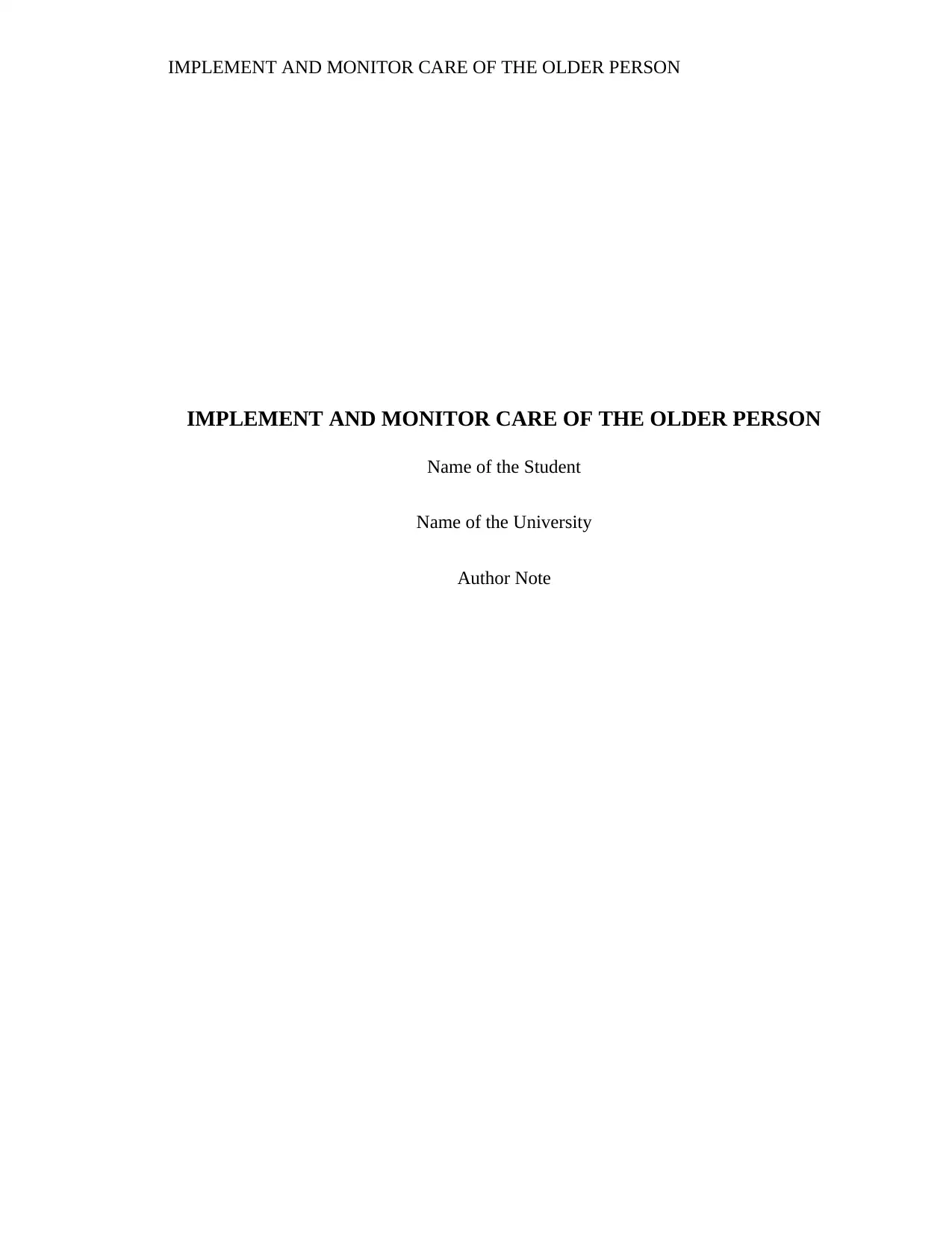
IMPLEMENT AND MONITOR CARE OF THE OLDER PERSON
IMPLEMENT AND MONITOR CARE OF THE OLDER PERSON
Name of the Student
Name of the University
Author Note
IMPLEMENT AND MONITOR CARE OF THE OLDER PERSON
Name of the Student
Name of the University
Author Note
Secure Best Marks with AI Grader
Need help grading? Try our AI Grader for instant feedback on your assignments.

1IMPLEMENT AND MONITOR CARE OF THE OLDER PERSON
Table of Contents
Part A:..................................................................................................................................2
Medical Diagnosis:..........................................................................................................2
Theory of Ageing:............................................................................................................3
Physiology of Ageing:.....................................................................................................4
Primary health services:...................................................................................................5
Strategies and Interventions for dementia and challenging behaviours:.........................6
Oral Hygiene:...................................................................................................................7
Pain:.................................................................................................................................8
Complementary Therapies:..............................................................................................9
Part B:................................................................................................................................10
Nursing care plan:.........................................................................................................10
References:........................................................................................................................14
Table of Contents
Part A:..................................................................................................................................2
Medical Diagnosis:..........................................................................................................2
Theory of Ageing:............................................................................................................3
Physiology of Ageing:.....................................................................................................4
Primary health services:...................................................................................................5
Strategies and Interventions for dementia and challenging behaviours:.........................6
Oral Hygiene:...................................................................................................................7
Pain:.................................................................................................................................8
Complementary Therapies:..............................................................................................9
Part B:................................................................................................................................10
Nursing care plan:.........................................................................................................10
References:........................................................................................................................14

2IMPLEMENT AND MONITOR CARE OF THE OLDER PERSON
Part A:
Medical Diagnosis:
This part discusses the medical history of Mr John Woods, who is an eighty-five years
old male. According to the medical reports, he was seen to have experienced from a heart attack
eight years ago. He also suffered from hypertension thirteen years ago. Recent records proved
the presence of osteoarthritis and gout in his left knee. Depression and anxiety were also
diagnosed two years ago. Involuntary urination, along with Alzheimer's dementia, was also
found in his recent medical records. Doctors have asked him to move with a wheelchair. This
condition of him was responsible for his left knee pain. According to the records, Mr John has
been found to have suffered from falling two times in six months. However, he never
experienced any injury from the falls. The above-stated records prove the presence of specific
psychological and physical problems associated with Mr John. Some of the issues include
forgetting to eat at the right time, not recognizing the time for daily activity and holding the left
knee while walking. Also included are getting showers at late night and getting sad while finding
his sister. All these problems were noted during his tenure in hospital. As a result, it can be stated
that his past medical history significantly impacts his present condition.
Part A:
Medical Diagnosis:
This part discusses the medical history of Mr John Woods, who is an eighty-five years
old male. According to the medical reports, he was seen to have experienced from a heart attack
eight years ago. He also suffered from hypertension thirteen years ago. Recent records proved
the presence of osteoarthritis and gout in his left knee. Depression and anxiety were also
diagnosed two years ago. Involuntary urination, along with Alzheimer's dementia, was also
found in his recent medical records. Doctors have asked him to move with a wheelchair. This
condition of him was responsible for his left knee pain. According to the records, Mr John has
been found to have suffered from falling two times in six months. However, he never
experienced any injury from the falls. The above-stated records prove the presence of specific
psychological and physical problems associated with Mr John. Some of the issues include
forgetting to eat at the right time, not recognizing the time for daily activity and holding the left
knee while walking. Also included are getting showers at late night and getting sad while finding
his sister. All these problems were noted during his tenure in hospital. As a result, it can be stated
that his past medical history significantly impacts his present condition.

3IMPLEMENT AND MONITOR CARE OF THE OLDER PERSON
Theory of Ageing:
Many mechanisms and theories exist for age-related changes and the process of ageing.
Most of the theories that are used to describe the age-related issues consist of three points
(Iwarsson, 2018):
Problems associated with ageing must always be occurring in all members of the
human population.
The age-related problems must be progressive with time. The older the person
grows, the more the effectiveness of the health issue.
The changes must always be an organ dysfunction, ultimately causing the human
body to fail.
There are two theories of ageing; one is a non-programmed theory (based on evolutionary
concepts). The other is a programmed theory (ageing and age-related issues as a result of
biological changes inside the human body). Another method is also available called the damage
or error theory. This theory is more applicable in every case since it states that ageing is a result
of damaging vital parts and tissues with an increase in age (Gladyshev, 2014). According to the
case study provided, medical reports of Mr John mainly states about damaging effects inside his
body. In a broader sense, damage of internal organs, cells and tissues, bones and muscle
destruction are the main reasons for the death of a person at a very high age. This theory can be
related to this study. Mr Woods was suffering from osteoarthritis (bone problem) and a heart
attack history which has made his body weaker with age. He was also found to suffer from
Alzheimer's dementia which is very prevalent in old aged people (Alzheimer, 2015). Brain cells
decay in Alzheimer's disease, which makes the patient lose his consciousness, and this is evident
Theory of Ageing:
Many mechanisms and theories exist for age-related changes and the process of ageing.
Most of the theories that are used to describe the age-related issues consist of three points
(Iwarsson, 2018):
Problems associated with ageing must always be occurring in all members of the
human population.
The age-related problems must be progressive with time. The older the person
grows, the more the effectiveness of the health issue.
The changes must always be an organ dysfunction, ultimately causing the human
body to fail.
There are two theories of ageing; one is a non-programmed theory (based on evolutionary
concepts). The other is a programmed theory (ageing and age-related issues as a result of
biological changes inside the human body). Another method is also available called the damage
or error theory. This theory is more applicable in every case since it states that ageing is a result
of damaging vital parts and tissues with an increase in age (Gladyshev, 2014). According to the
case study provided, medical reports of Mr John mainly states about damaging effects inside his
body. In a broader sense, damage of internal organs, cells and tissues, bones and muscle
destruction are the main reasons for the death of a person at a very high age. This theory can be
related to this study. Mr Woods was suffering from osteoarthritis (bone problem) and a heart
attack history which has made his body weaker with age. He was also found to suffer from
Alzheimer's dementia which is very prevalent in old aged people (Alzheimer, 2015). Brain cells
decay in Alzheimer's disease, which makes the patient lose his consciousness, and this is evident
Secure Best Marks with AI Grader
Need help grading? Try our AI Grader for instant feedback on your assignments.
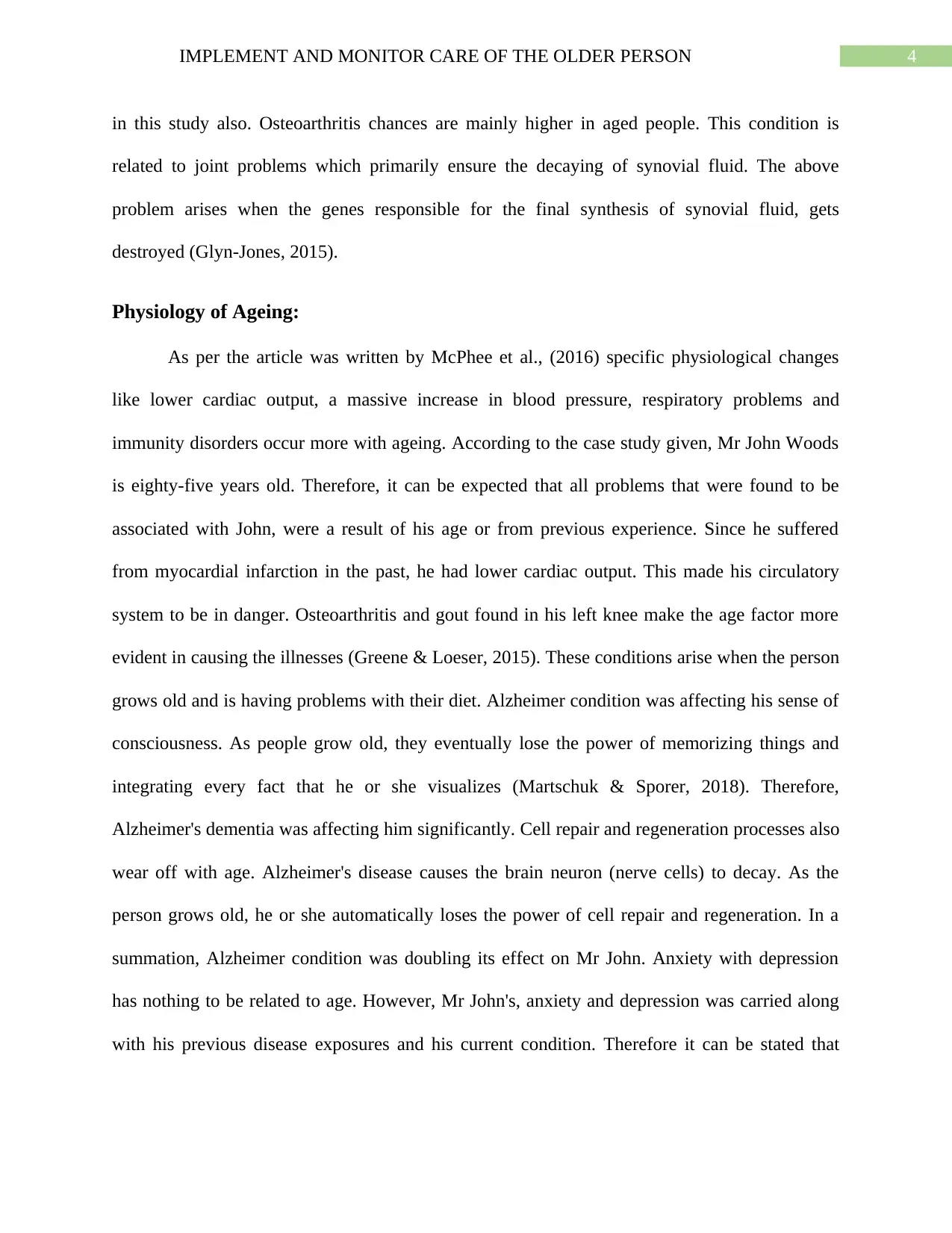
4IMPLEMENT AND MONITOR CARE OF THE OLDER PERSON
in this study also. Osteoarthritis chances are mainly higher in aged people. This condition is
related to joint problems which primarily ensure the decaying of synovial fluid. The above
problem arises when the genes responsible for the final synthesis of synovial fluid, gets
destroyed (Glyn-Jones, 2015).
Physiology of Ageing:
As per the article was written by McPhee et al., (2016) specific physiological changes
like lower cardiac output, a massive increase in blood pressure, respiratory problems and
immunity disorders occur more with ageing. According to the case study given, Mr John Woods
is eighty-five years old. Therefore, it can be expected that all problems that were found to be
associated with John, were a result of his age or from previous experience. Since he suffered
from myocardial infarction in the past, he had lower cardiac output. This made his circulatory
system to be in danger. Osteoarthritis and gout found in his left knee make the age factor more
evident in causing the illnesses (Greene & Loeser, 2015). These conditions arise when the person
grows old and is having problems with their diet. Alzheimer condition was affecting his sense of
consciousness. As people grow old, they eventually lose the power of memorizing things and
integrating every fact that he or she visualizes (Martschuk & Sporer, 2018). Therefore,
Alzheimer's dementia was affecting him significantly. Cell repair and regeneration processes also
wear off with age. Alzheimer's disease causes the brain neuron (nerve cells) to decay. As the
person grows old, he or she automatically loses the power of cell repair and regeneration. In a
summation, Alzheimer condition was doubling its effect on Mr John. Anxiety with depression
has nothing to be related to age. However, Mr John's, anxiety and depression was carried along
with his previous disease exposures and his current condition. Therefore it can be stated that
in this study also. Osteoarthritis chances are mainly higher in aged people. This condition is
related to joint problems which primarily ensure the decaying of synovial fluid. The above
problem arises when the genes responsible for the final synthesis of synovial fluid, gets
destroyed (Glyn-Jones, 2015).
Physiology of Ageing:
As per the article was written by McPhee et al., (2016) specific physiological changes
like lower cardiac output, a massive increase in blood pressure, respiratory problems and
immunity disorders occur more with ageing. According to the case study given, Mr John Woods
is eighty-five years old. Therefore, it can be expected that all problems that were found to be
associated with John, were a result of his age or from previous experience. Since he suffered
from myocardial infarction in the past, he had lower cardiac output. This made his circulatory
system to be in danger. Osteoarthritis and gout found in his left knee make the age factor more
evident in causing the illnesses (Greene & Loeser, 2015). These conditions arise when the person
grows old and is having problems with their diet. Alzheimer condition was affecting his sense of
consciousness. As people grow old, they eventually lose the power of memorizing things and
integrating every fact that he or she visualizes (Martschuk & Sporer, 2018). Therefore,
Alzheimer's dementia was affecting him significantly. Cell repair and regeneration processes also
wear off with age. Alzheimer's disease causes the brain neuron (nerve cells) to decay. As the
person grows old, he or she automatically loses the power of cell repair and regeneration. In a
summation, Alzheimer condition was doubling its effect on Mr John. Anxiety with depression
has nothing to be related to age. However, Mr John's, anxiety and depression was carried along
with his previous disease exposures and his current condition. Therefore it can be stated that
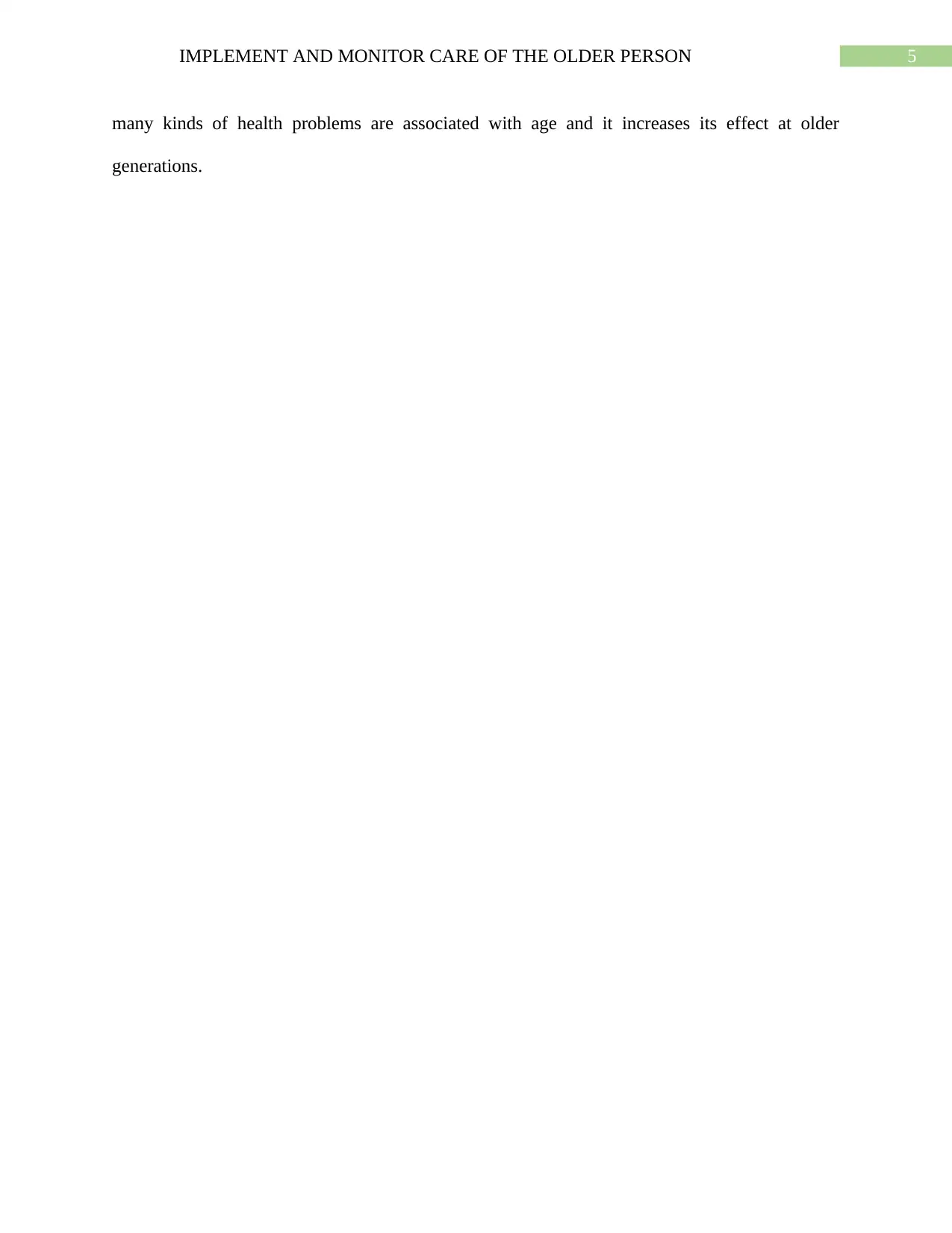
5IMPLEMENT AND MONITOR CARE OF THE OLDER PERSON
many kinds of health problems are associated with age and it increases its effect at older
generations.
many kinds of health problems are associated with age and it increases its effect at older
generations.
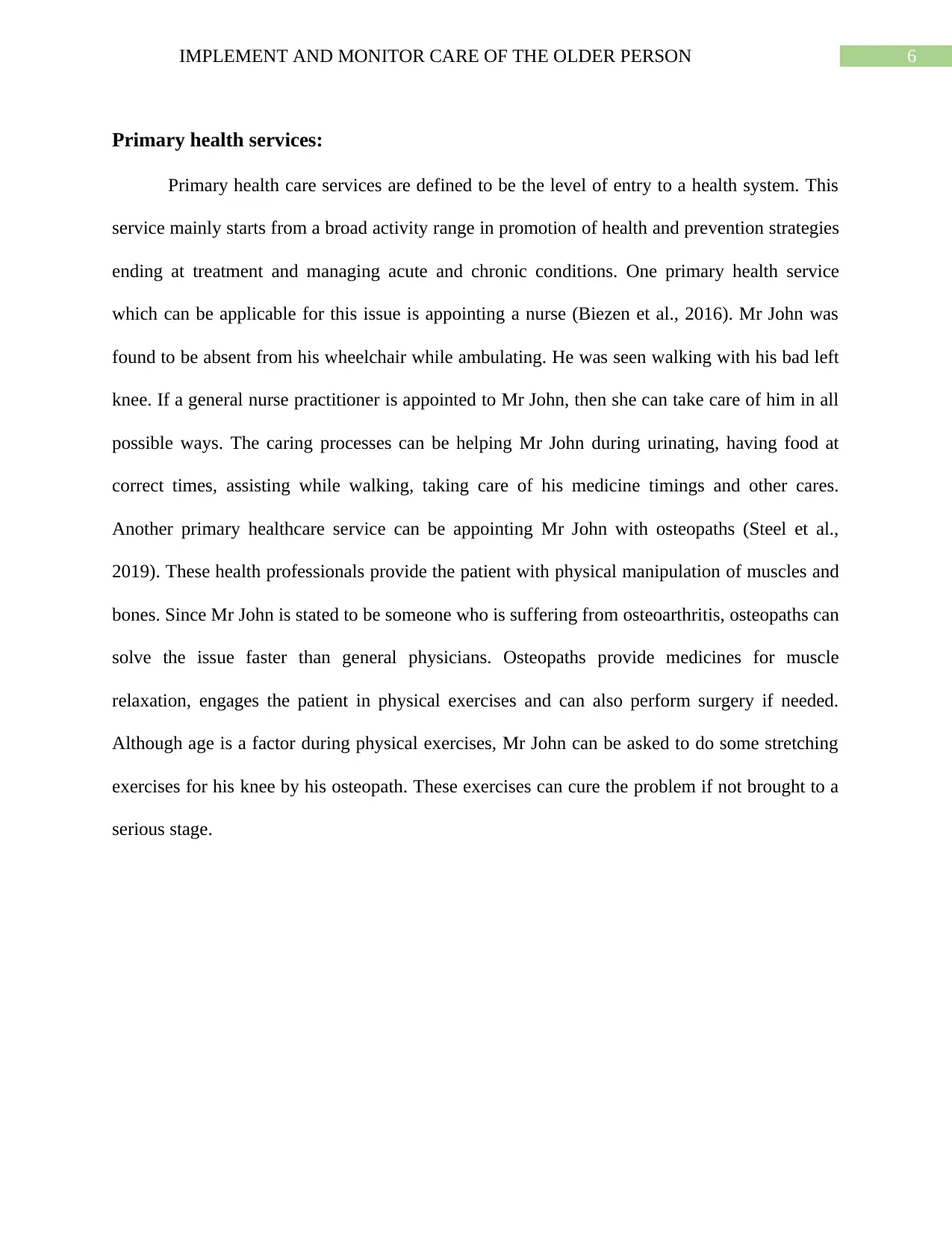
6IMPLEMENT AND MONITOR CARE OF THE OLDER PERSON
Primary health services:
Primary health care services are defined to be the level of entry to a health system. This
service mainly starts from a broad activity range in promotion of health and prevention strategies
ending at treatment and managing acute and chronic conditions. One primary health service
which can be applicable for this issue is appointing a nurse (Biezen et al., 2016). Mr John was
found to be absent from his wheelchair while ambulating. He was seen walking with his bad left
knee. If a general nurse practitioner is appointed to Mr John, then she can take care of him in all
possible ways. The caring processes can be helping Mr John during urinating, having food at
correct times, assisting while walking, taking care of his medicine timings and other cares.
Another primary healthcare service can be appointing Mr John with osteopaths (Steel et al.,
2019). These health professionals provide the patient with physical manipulation of muscles and
bones. Since Mr John is stated to be someone who is suffering from osteoarthritis, osteopaths can
solve the issue faster than general physicians. Osteopaths provide medicines for muscle
relaxation, engages the patient in physical exercises and can also perform surgery if needed.
Although age is a factor during physical exercises, Mr John can be asked to do some stretching
exercises for his knee by his osteopath. These exercises can cure the problem if not brought to a
serious stage.
Primary health services:
Primary health care services are defined to be the level of entry to a health system. This
service mainly starts from a broad activity range in promotion of health and prevention strategies
ending at treatment and managing acute and chronic conditions. One primary health service
which can be applicable for this issue is appointing a nurse (Biezen et al., 2016). Mr John was
found to be absent from his wheelchair while ambulating. He was seen walking with his bad left
knee. If a general nurse practitioner is appointed to Mr John, then she can take care of him in all
possible ways. The caring processes can be helping Mr John during urinating, having food at
correct times, assisting while walking, taking care of his medicine timings and other cares.
Another primary healthcare service can be appointing Mr John with osteopaths (Steel et al.,
2019). These health professionals provide the patient with physical manipulation of muscles and
bones. Since Mr John is stated to be someone who is suffering from osteoarthritis, osteopaths can
solve the issue faster than general physicians. Osteopaths provide medicines for muscle
relaxation, engages the patient in physical exercises and can also perform surgery if needed.
Although age is a factor during physical exercises, Mr John can be asked to do some stretching
exercises for his knee by his osteopath. These exercises can cure the problem if not brought to a
serious stage.
Paraphrase This Document
Need a fresh take? Get an instant paraphrase of this document with our AI Paraphraser
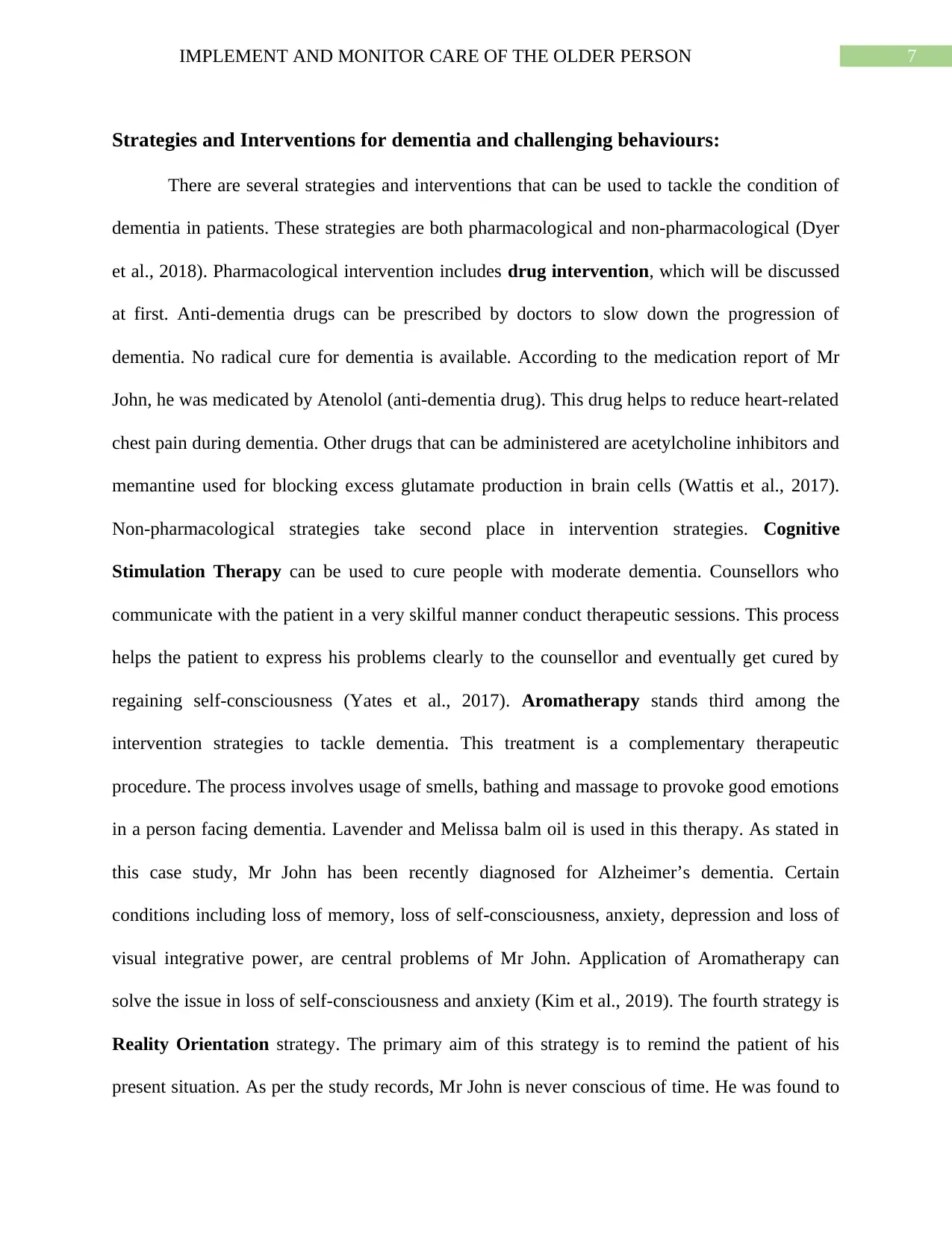
7IMPLEMENT AND MONITOR CARE OF THE OLDER PERSON
Strategies and Interventions for dementia and challenging behaviours:
There are several strategies and interventions that can be used to tackle the condition of
dementia in patients. These strategies are both pharmacological and non-pharmacological (Dyer
et al., 2018). Pharmacological intervention includes drug intervention, which will be discussed
at first. Anti-dementia drugs can be prescribed by doctors to slow down the progression of
dementia. No radical cure for dementia is available. According to the medication report of Mr
John, he was medicated by Atenolol (anti-dementia drug). This drug helps to reduce heart-related
chest pain during dementia. Other drugs that can be administered are acetylcholine inhibitors and
memantine used for blocking excess glutamate production in brain cells (Wattis et al., 2017).
Non-pharmacological strategies take second place in intervention strategies. Cognitive
Stimulation Therapy can be used to cure people with moderate dementia. Counsellors who
communicate with the patient in a very skilful manner conduct therapeutic sessions. This process
helps the patient to express his problems clearly to the counsellor and eventually get cured by
regaining self-consciousness (Yates et al., 2017). Aromatherapy stands third among the
intervention strategies to tackle dementia. This treatment is a complementary therapeutic
procedure. The process involves usage of smells, bathing and massage to provoke good emotions
in a person facing dementia. Lavender and Melissa balm oil is used in this therapy. As stated in
this case study, Mr John has been recently diagnosed for Alzheimer’s dementia. Certain
conditions including loss of memory, loss of self-consciousness, anxiety, depression and loss of
visual integrative power, are central problems of Mr John. Application of Aromatherapy can
solve the issue in loss of self-consciousness and anxiety (Kim et al., 2019). The fourth strategy is
Reality Orientation strategy. The primary aim of this strategy is to remind the patient of his
present situation. As per the study records, Mr John is never conscious of time. He was found to
Strategies and Interventions for dementia and challenging behaviours:
There are several strategies and interventions that can be used to tackle the condition of
dementia in patients. These strategies are both pharmacological and non-pharmacological (Dyer
et al., 2018). Pharmacological intervention includes drug intervention, which will be discussed
at first. Anti-dementia drugs can be prescribed by doctors to slow down the progression of
dementia. No radical cure for dementia is available. According to the medication report of Mr
John, he was medicated by Atenolol (anti-dementia drug). This drug helps to reduce heart-related
chest pain during dementia. Other drugs that can be administered are acetylcholine inhibitors and
memantine used for blocking excess glutamate production in brain cells (Wattis et al., 2017).
Non-pharmacological strategies take second place in intervention strategies. Cognitive
Stimulation Therapy can be used to cure people with moderate dementia. Counsellors who
communicate with the patient in a very skilful manner conduct therapeutic sessions. This process
helps the patient to express his problems clearly to the counsellor and eventually get cured by
regaining self-consciousness (Yates et al., 2017). Aromatherapy stands third among the
intervention strategies to tackle dementia. This treatment is a complementary therapeutic
procedure. The process involves usage of smells, bathing and massage to provoke good emotions
in a person facing dementia. Lavender and Melissa balm oil is used in this therapy. As stated in
this case study, Mr John has been recently diagnosed for Alzheimer’s dementia. Certain
conditions including loss of memory, loss of self-consciousness, anxiety, depression and loss of
visual integrative power, are central problems of Mr John. Application of Aromatherapy can
solve the issue in loss of self-consciousness and anxiety (Kim et al., 2019). The fourth strategy is
Reality Orientation strategy. The primary aim of this strategy is to remind the patient of his
present situation. As per the study records, Mr John is never conscious of time. He was found to
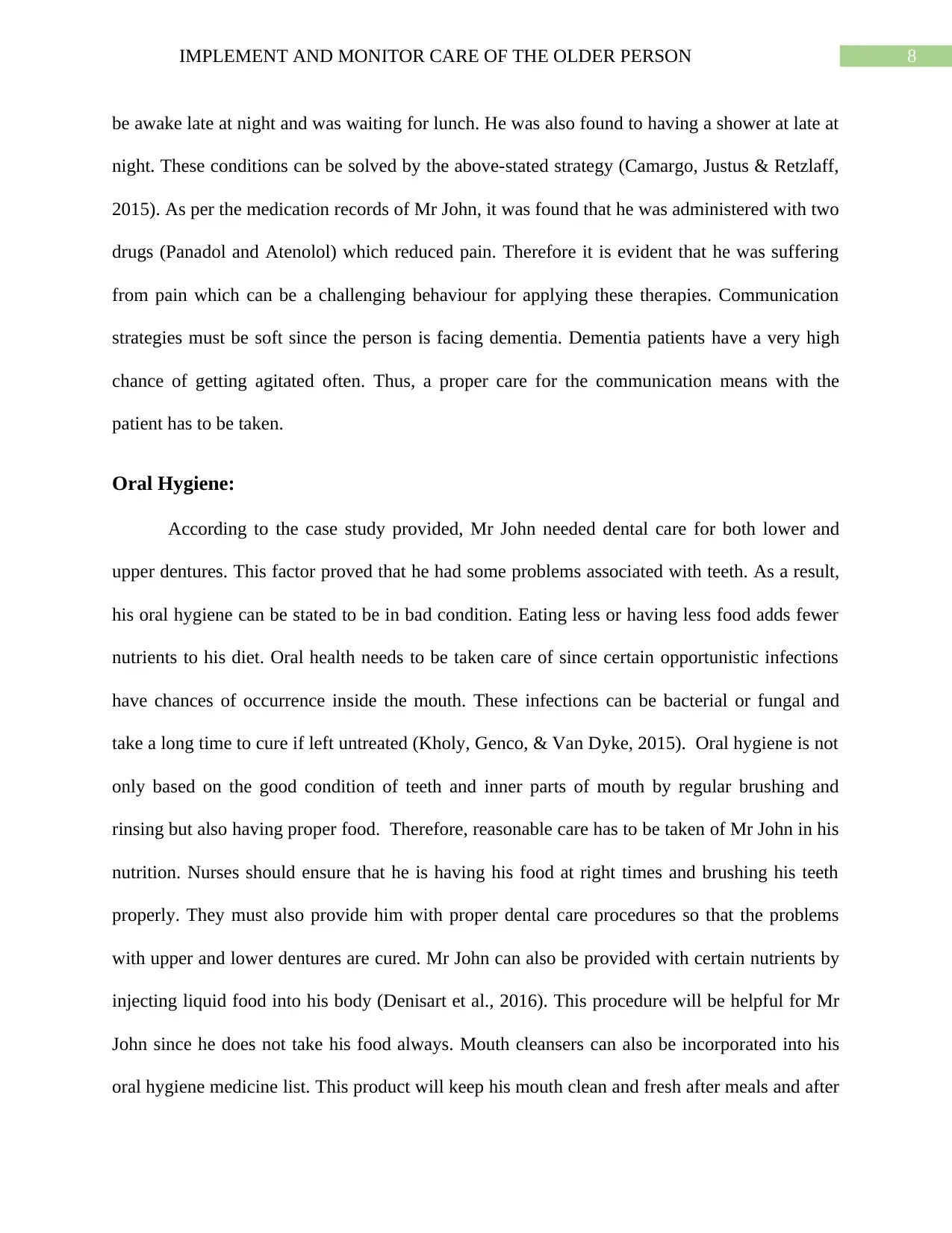
8IMPLEMENT AND MONITOR CARE OF THE OLDER PERSON
be awake late at night and was waiting for lunch. He was also found to having a shower at late at
night. These conditions can be solved by the above-stated strategy (Camargo, Justus & Retzlaff,
2015). As per the medication records of Mr John, it was found that he was administered with two
drugs (Panadol and Atenolol) which reduced pain. Therefore it is evident that he was suffering
from pain which can be a challenging behaviour for applying these therapies. Communication
strategies must be soft since the person is facing dementia. Dementia patients have a very high
chance of getting agitated often. Thus, a proper care for the communication means with the
patient has to be taken.
Oral Hygiene:
According to the case study provided, Mr John needed dental care for both lower and
upper dentures. This factor proved that he had some problems associated with teeth. As a result,
his oral hygiene can be stated to be in bad condition. Eating less or having less food adds fewer
nutrients to his diet. Oral health needs to be taken care of since certain opportunistic infections
have chances of occurrence inside the mouth. These infections can be bacterial or fungal and
take a long time to cure if left untreated (Kholy, Genco, & Van Dyke, 2015). Oral hygiene is not
only based on the good condition of teeth and inner parts of mouth by regular brushing and
rinsing but also having proper food. Therefore, reasonable care has to be taken of Mr John in his
nutrition. Nurses should ensure that he is having his food at right times and brushing his teeth
properly. They must also provide him with proper dental care procedures so that the problems
with upper and lower dentures are cured. Mr John can also be provided with certain nutrients by
injecting liquid food into his body (Denisart et al., 2016). This procedure will be helpful for Mr
John since he does not take his food always. Mouth cleansers can also be incorporated into his
oral hygiene medicine list. This product will keep his mouth clean and fresh after meals and after
be awake late at night and was waiting for lunch. He was also found to having a shower at late at
night. These conditions can be solved by the above-stated strategy (Camargo, Justus & Retzlaff,
2015). As per the medication records of Mr John, it was found that he was administered with two
drugs (Panadol and Atenolol) which reduced pain. Therefore it is evident that he was suffering
from pain which can be a challenging behaviour for applying these therapies. Communication
strategies must be soft since the person is facing dementia. Dementia patients have a very high
chance of getting agitated often. Thus, a proper care for the communication means with the
patient has to be taken.
Oral Hygiene:
According to the case study provided, Mr John needed dental care for both lower and
upper dentures. This factor proved that he had some problems associated with teeth. As a result,
his oral hygiene can be stated to be in bad condition. Eating less or having less food adds fewer
nutrients to his diet. Oral health needs to be taken care of since certain opportunistic infections
have chances of occurrence inside the mouth. These infections can be bacterial or fungal and
take a long time to cure if left untreated (Kholy, Genco, & Van Dyke, 2015). Oral hygiene is not
only based on the good condition of teeth and inner parts of mouth by regular brushing and
rinsing but also having proper food. Therefore, reasonable care has to be taken of Mr John in his
nutrition. Nurses should ensure that he is having his food at right times and brushing his teeth
properly. They must also provide him with proper dental care procedures so that the problems
with upper and lower dentures are cured. Mr John can also be provided with certain nutrients by
injecting liquid food into his body (Denisart et al., 2016). This procedure will be helpful for Mr
John since he does not take his food always. Mouth cleansers can also be incorporated into his
oral hygiene medicine list. This product will keep his mouth clean and fresh after meals and after

9IMPLEMENT AND MONITOR CARE OF THE OLDER PERSON
waking up. On a summary, these are the oral hygiene procedures that can be implemented in the
case of Mr John.
Pain:
The primary evidence of the person is suffering from pain is the condition of his left
knee. According to the case study provided, Mr John has been suffering from a left knee pain
which also made his walking difficult than before. PRN Panadol, Voltaren Emulgel and Atenolol
are all pain-reducing drugs and ointments (Palmer, 2016). These drugs were observed in the
medical records provided for Mr John. As a result, it can be stated that Mr John was
experiencing pain in moderate to severe levels. The fact that Mr John has been suffering from
pain even after medications is evident from his present condition. According to the case study,
Mr John has been found to suffer from left knee gout and osteoarthritis. Therefore, new and more
effective drugs can be administered to reduce his pain. Osteoarthritis has to be solved too to
lessen the physical sufferings from the root cause. RICE (Rest, ice, compression, and elevation)
strategy can be used to cure knee pains which arise from arthritis (Gillette & Merrick, 2018).
This is a prolonged process but much useful because it does not include the use of synthetic
drugs. NSAID (Non-Stimulatory Anti-inflammatory Drugs) can be administered to cure knee
pain problem. These drugs are Ibuprofen and Naproxen (Edwards et al., 2016). They act directly
on the target site and do not cause any inflammation upon action. Therefore this strategy can be
safer for Mr John, who already has gout on left knee.
waking up. On a summary, these are the oral hygiene procedures that can be implemented in the
case of Mr John.
Pain:
The primary evidence of the person is suffering from pain is the condition of his left
knee. According to the case study provided, Mr John has been suffering from a left knee pain
which also made his walking difficult than before. PRN Panadol, Voltaren Emulgel and Atenolol
are all pain-reducing drugs and ointments (Palmer, 2016). These drugs were observed in the
medical records provided for Mr John. As a result, it can be stated that Mr John was
experiencing pain in moderate to severe levels. The fact that Mr John has been suffering from
pain even after medications is evident from his present condition. According to the case study,
Mr John has been found to suffer from left knee gout and osteoarthritis. Therefore, new and more
effective drugs can be administered to reduce his pain. Osteoarthritis has to be solved too to
lessen the physical sufferings from the root cause. RICE (Rest, ice, compression, and elevation)
strategy can be used to cure knee pains which arise from arthritis (Gillette & Merrick, 2018).
This is a prolonged process but much useful because it does not include the use of synthetic
drugs. NSAID (Non-Stimulatory Anti-inflammatory Drugs) can be administered to cure knee
pain problem. These drugs are Ibuprofen and Naproxen (Edwards et al., 2016). They act directly
on the target site and do not cause any inflammation upon action. Therefore this strategy can be
safer for Mr John, who already has gout on left knee.
Secure Best Marks with AI Grader
Need help grading? Try our AI Grader for instant feedback on your assignments.
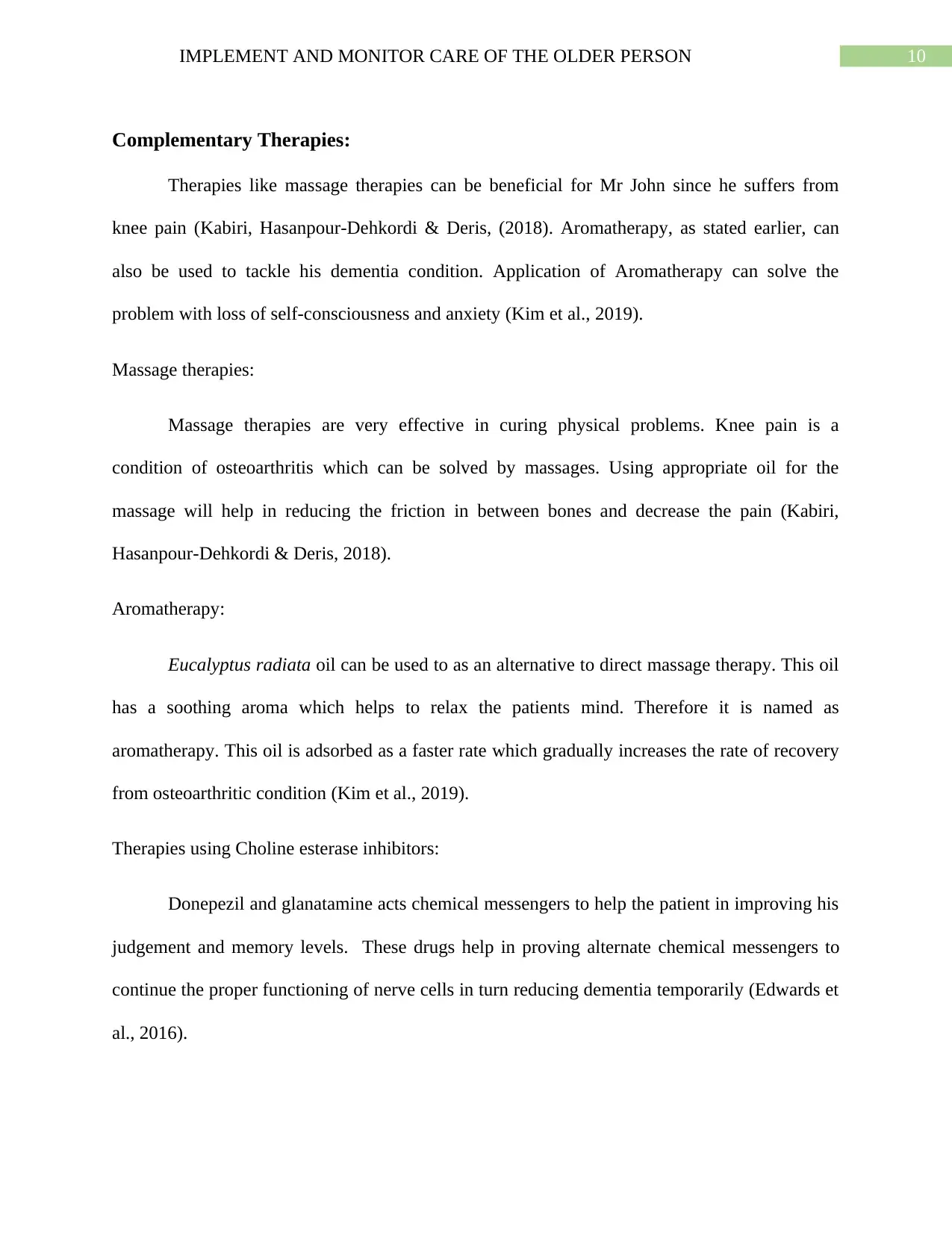
10IMPLEMENT AND MONITOR CARE OF THE OLDER PERSON
Complementary Therapies:
Therapies like massage therapies can be beneficial for Mr John since he suffers from
knee pain (Kabiri, Hasanpour-Dehkordi & Deris, (2018). Aromatherapy, as stated earlier, can
also be used to tackle his dementia condition. Application of Aromatherapy can solve the
problem with loss of self-consciousness and anxiety (Kim et al., 2019).
Massage therapies:
Massage therapies are very effective in curing physical problems. Knee pain is a
condition of osteoarthritis which can be solved by massages. Using appropriate oil for the
massage will help in reducing the friction in between bones and decrease the pain (Kabiri,
Hasanpour-Dehkordi & Deris, 2018).
Aromatherapy:
Eucalyptus radiata oil can be used to as an alternative to direct massage therapy. This oil
has a soothing aroma which helps to relax the patients mind. Therefore it is named as
aromatherapy. This oil is adsorbed as a faster rate which gradually increases the rate of recovery
from osteoarthritic condition (Kim et al., 2019).
Therapies using Choline esterase inhibitors:
Donepezil and glanatamine acts chemical messengers to help the patient in improving his
judgement and memory levels. These drugs help in proving alternate chemical messengers to
continue the proper functioning of nerve cells in turn reducing dementia temporarily (Edwards et
al., 2016).
Complementary Therapies:
Therapies like massage therapies can be beneficial for Mr John since he suffers from
knee pain (Kabiri, Hasanpour-Dehkordi & Deris, (2018). Aromatherapy, as stated earlier, can
also be used to tackle his dementia condition. Application of Aromatherapy can solve the
problem with loss of self-consciousness and anxiety (Kim et al., 2019).
Massage therapies:
Massage therapies are very effective in curing physical problems. Knee pain is a
condition of osteoarthritis which can be solved by massages. Using appropriate oil for the
massage will help in reducing the friction in between bones and decrease the pain (Kabiri,
Hasanpour-Dehkordi & Deris, 2018).
Aromatherapy:
Eucalyptus radiata oil can be used to as an alternative to direct massage therapy. This oil
has a soothing aroma which helps to relax the patients mind. Therefore it is named as
aromatherapy. This oil is adsorbed as a faster rate which gradually increases the rate of recovery
from osteoarthritic condition (Kim et al., 2019).
Therapies using Choline esterase inhibitors:
Donepezil and glanatamine acts chemical messengers to help the patient in improving his
judgement and memory levels. These drugs help in proving alternate chemical messengers to
continue the proper functioning of nerve cells in turn reducing dementia temporarily (Edwards et
al., 2016).
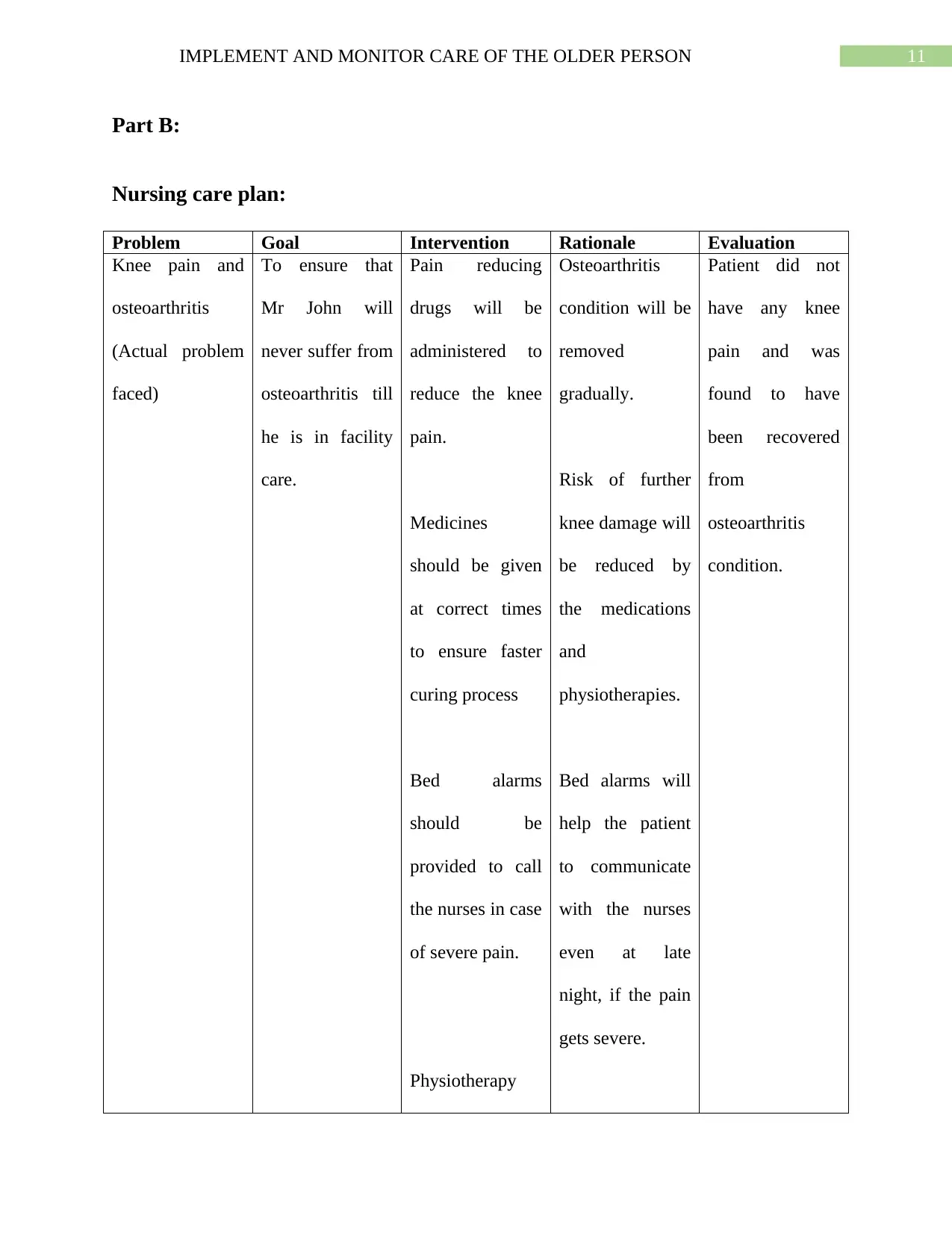
11IMPLEMENT AND MONITOR CARE OF THE OLDER PERSON
Part B:
Nursing care plan:
Problem Goal Intervention Rationale Evaluation
Knee pain and
osteoarthritis
(Actual problem
faced)
To ensure that
Mr John will
never suffer from
osteoarthritis till
he is in facility
care.
Pain reducing
drugs will be
administered to
reduce the knee
pain.
Medicines
should be given
at correct times
to ensure faster
curing process
Bed alarms
should be
provided to call
the nurses in case
of severe pain.
Physiotherapy
Osteoarthritis
condition will be
removed
gradually.
Risk of further
knee damage will
be reduced by
the medications
and
physiotherapies.
Bed alarms will
help the patient
to communicate
with the nurses
even at late
night, if the pain
gets severe.
Patient did not
have any knee
pain and was
found to have
been recovered
from
osteoarthritis
condition.
Part B:
Nursing care plan:
Problem Goal Intervention Rationale Evaluation
Knee pain and
osteoarthritis
(Actual problem
faced)
To ensure that
Mr John will
never suffer from
osteoarthritis till
he is in facility
care.
Pain reducing
drugs will be
administered to
reduce the knee
pain.
Medicines
should be given
at correct times
to ensure faster
curing process
Bed alarms
should be
provided to call
the nurses in case
of severe pain.
Physiotherapy
Osteoarthritis
condition will be
removed
gradually.
Risk of further
knee damage will
be reduced by
the medications
and
physiotherapies.
Bed alarms will
help the patient
to communicate
with the nurses
even at late
night, if the pain
gets severe.
Patient did not
have any knee
pain and was
found to have
been recovered
from
osteoarthritis
condition.
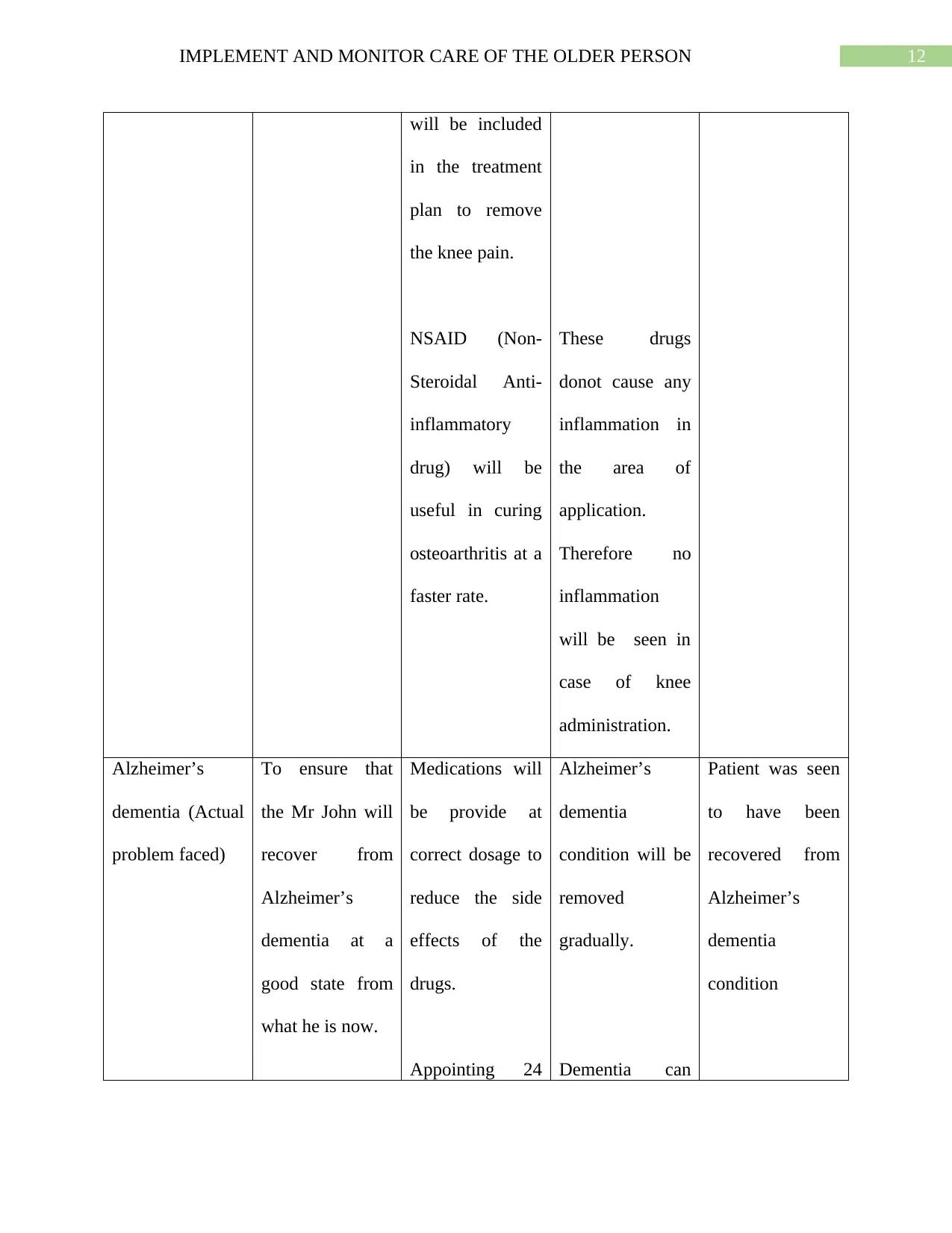
12IMPLEMENT AND MONITOR CARE OF THE OLDER PERSON
will be included
in the treatment
plan to remove
the knee pain.
NSAID (Non-
Steroidal Anti-
inflammatory
drug) will be
useful in curing
osteoarthritis at a
faster rate.
These drugs
donot cause any
inflammation in
the area of
application.
Therefore no
inflammation
will be seen in
case of knee
administration.
Alzheimer’s
dementia (Actual
problem faced)
To ensure that
the Mr John will
recover from
Alzheimer’s
dementia at a
good state from
what he is now.
Medications will
be provide at
correct dosage to
reduce the side
effects of the
drugs.
Appointing 24
Alzheimer’s
dementia
condition will be
removed
gradually.
Dementia can
Patient was seen
to have been
recovered from
Alzheimer’s
dementia
condition
will be included
in the treatment
plan to remove
the knee pain.
NSAID (Non-
Steroidal Anti-
inflammatory
drug) will be
useful in curing
osteoarthritis at a
faster rate.
These drugs
donot cause any
inflammation in
the area of
application.
Therefore no
inflammation
will be seen in
case of knee
administration.
Alzheimer’s
dementia (Actual
problem faced)
To ensure that
the Mr John will
recover from
Alzheimer’s
dementia at a
good state from
what he is now.
Medications will
be provide at
correct dosage to
reduce the side
effects of the
drugs.
Appointing 24
Alzheimer’s
dementia
condition will be
removed
gradually.
Dementia can
Patient was seen
to have been
recovered from
Alzheimer’s
dementia
condition
Paraphrase This Document
Need a fresh take? Get an instant paraphrase of this document with our AI Paraphraser
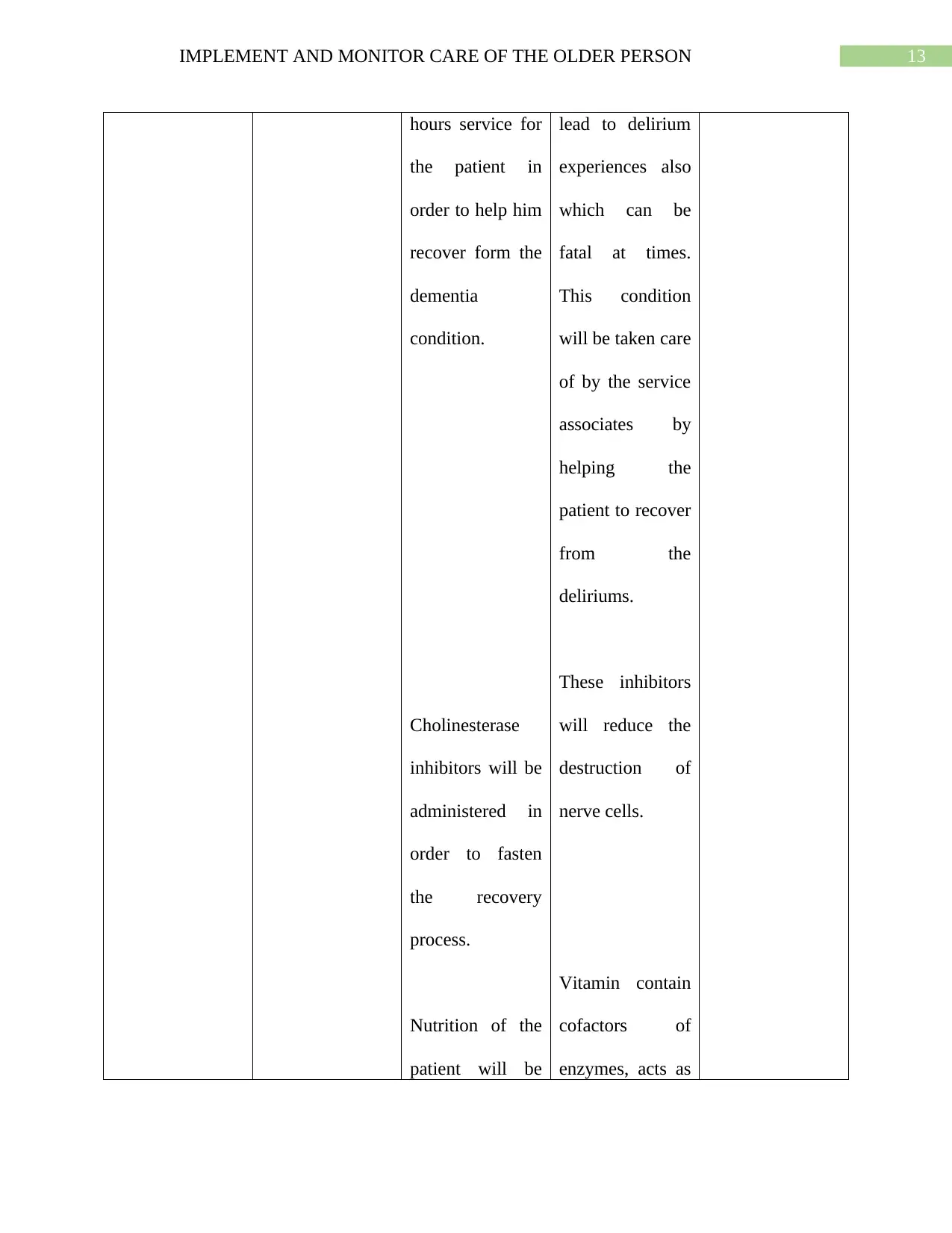
13IMPLEMENT AND MONITOR CARE OF THE OLDER PERSON
hours service for
the patient in
order to help him
recover form the
dementia
condition.
Cholinesterase
inhibitors will be
administered in
order to fasten
the recovery
process.
Nutrition of the
patient will be
lead to delirium
experiences also
which can be
fatal at times.
This condition
will be taken care
of by the service
associates by
helping the
patient to recover
from the
deliriums.
These inhibitors
will reduce the
destruction of
nerve cells.
Vitamin contain
cofactors of
enzymes, acts as
hours service for
the patient in
order to help him
recover form the
dementia
condition.
Cholinesterase
inhibitors will be
administered in
order to fasten
the recovery
process.
Nutrition of the
patient will be
lead to delirium
experiences also
which can be
fatal at times.
This condition
will be taken care
of by the service
associates by
helping the
patient to recover
from the
deliriums.
These inhibitors
will reduce the
destruction of
nerve cells.
Vitamin contain
cofactors of
enzymes, acts as

14IMPLEMENT AND MONITOR CARE OF THE OLDER PERSON
modified.
Vitamin
containing food
will be used in
order to maintain
a continuous
supply of
cofactors.
Cofactors will
help in
enzymatic
processes of cell
regeneration.
a functional
group for the
enzymes in order
to catalyse a
reaction.
Urinary
incontinence
(Potential
problem faced)
To ensure the
curing of
involuntary
urination.
Bladder training
will ensure the
control in
urination. This
training is done
by providing
efforts in
increasing the
time in between
urination rates.
Urinary bladder
is made up of
thin layer of
muscular wall.
The frequent
extension and
relaxation of this
wall can be
reduced by
increasing the
The problem of
urinary
incontinence was
being solved.
modified.
Vitamin
containing food
will be used in
order to maintain
a continuous
supply of
cofactors.
Cofactors will
help in
enzymatic
processes of cell
regeneration.
a functional
group for the
enzymes in order
to catalyse a
reaction.
Urinary
incontinence
(Potential
problem faced)
To ensure the
curing of
involuntary
urination.
Bladder training
will ensure the
control in
urination. This
training is done
by providing
efforts in
increasing the
time in between
urination rates.
Urinary bladder
is made up of
thin layer of
muscular wall.
The frequent
extension and
relaxation of this
wall can be
reduced by
increasing the
The problem of
urinary
incontinence was
being solved.
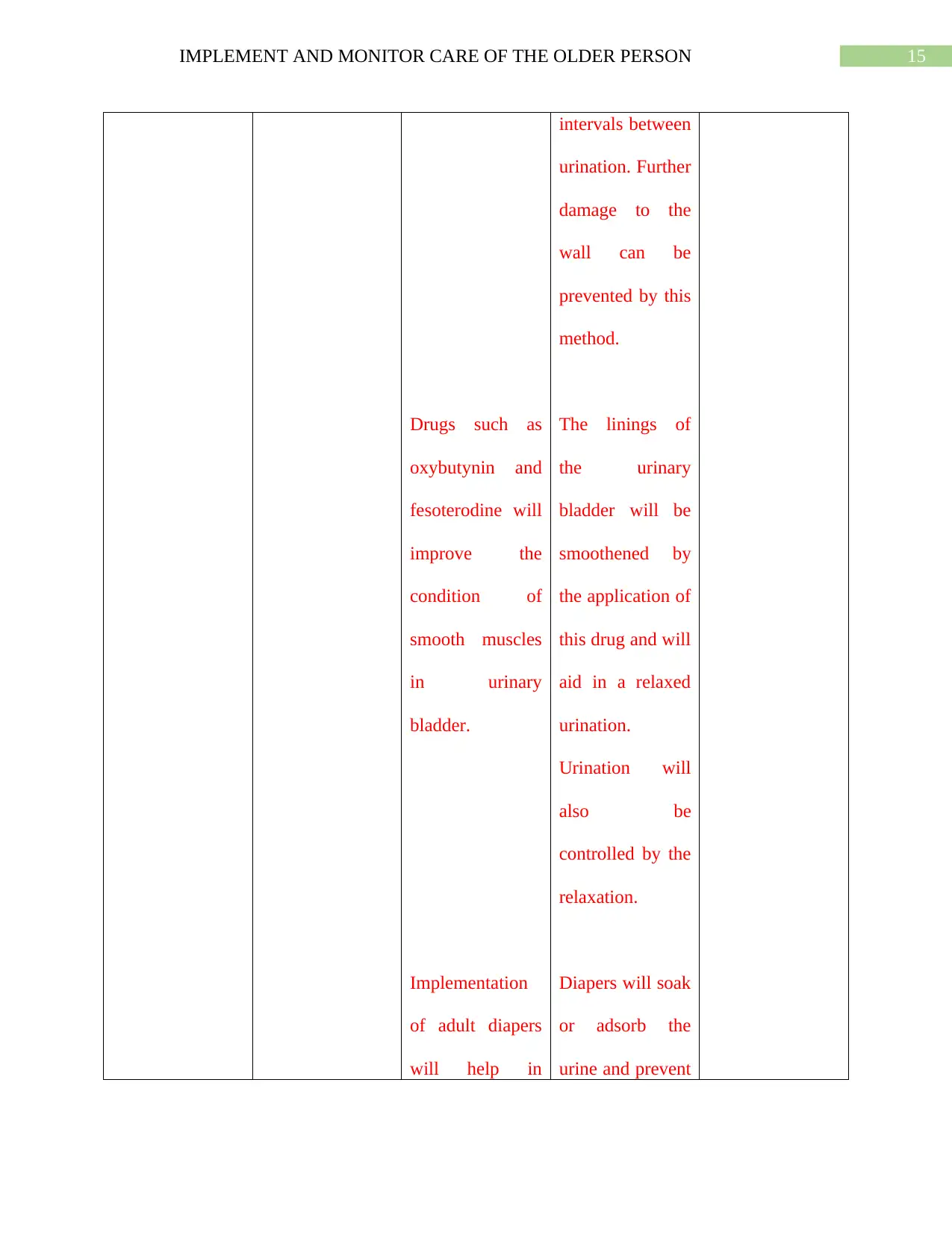
15IMPLEMENT AND MONITOR CARE OF THE OLDER PERSON
Drugs such as
oxybutynin and
fesoterodine will
improve the
condition of
smooth muscles
in urinary
bladder.
Implementation
of adult diapers
will help in
intervals between
urination. Further
damage to the
wall can be
prevented by this
method.
The linings of
the urinary
bladder will be
smoothened by
the application of
this drug and will
aid in a relaxed
urination.
Urination will
also be
controlled by the
relaxation.
Diapers will soak
or adsorb the
urine and prevent
Drugs such as
oxybutynin and
fesoterodine will
improve the
condition of
smooth muscles
in urinary
bladder.
Implementation
of adult diapers
will help in
intervals between
urination. Further
damage to the
wall can be
prevented by this
method.
The linings of
the urinary
bladder will be
smoothened by
the application of
this drug and will
aid in a relaxed
urination.
Urination will
also be
controlled by the
relaxation.
Diapers will soak
or adsorb the
urine and prevent
Secure Best Marks with AI Grader
Need help grading? Try our AI Grader for instant feedback on your assignments.

16IMPLEMENT AND MONITOR CARE OF THE OLDER PERSON
reducing the
chances of
infection
occurring
because of urine
storage between
the patient and
the bed.
its storage. This
condition will
prevent further
fungal infections.
Anxiety and
depression
(Potential
problem faced)
To ensure that
the patient is
relieved from
anxiety and
depression
conditions.
Psychotherapy
will help the
patient in getting
relieved from the
depression by
experiencing an
improvement in
psychological
condition.
Medications will
include the
administration of
Selective
Serotonin
Counselling the
patient will aid in
directly
improving the
patients mind set
by affecting his
current
psychological
status.
Serotonin
chemical
messengers are
increased in
production
Patient was seen
to have
recovered from
anxiety and
depression after
following this
intervention plan.
reducing the
chances of
infection
occurring
because of urine
storage between
the patient and
the bed.
its storage. This
condition will
prevent further
fungal infections.
Anxiety and
depression
(Potential
problem faced)
To ensure that
the patient is
relieved from
anxiety and
depression
conditions.
Psychotherapy
will help the
patient in getting
relieved from the
depression by
experiencing an
improvement in
psychological
condition.
Medications will
include the
administration of
Selective
Serotonin
Counselling the
patient will aid in
directly
improving the
patients mind set
by affecting his
current
psychological
status.
Serotonin
chemical
messengers are
increased in
production
Patient was seen
to have
recovered from
anxiety and
depression after
following this
intervention plan.
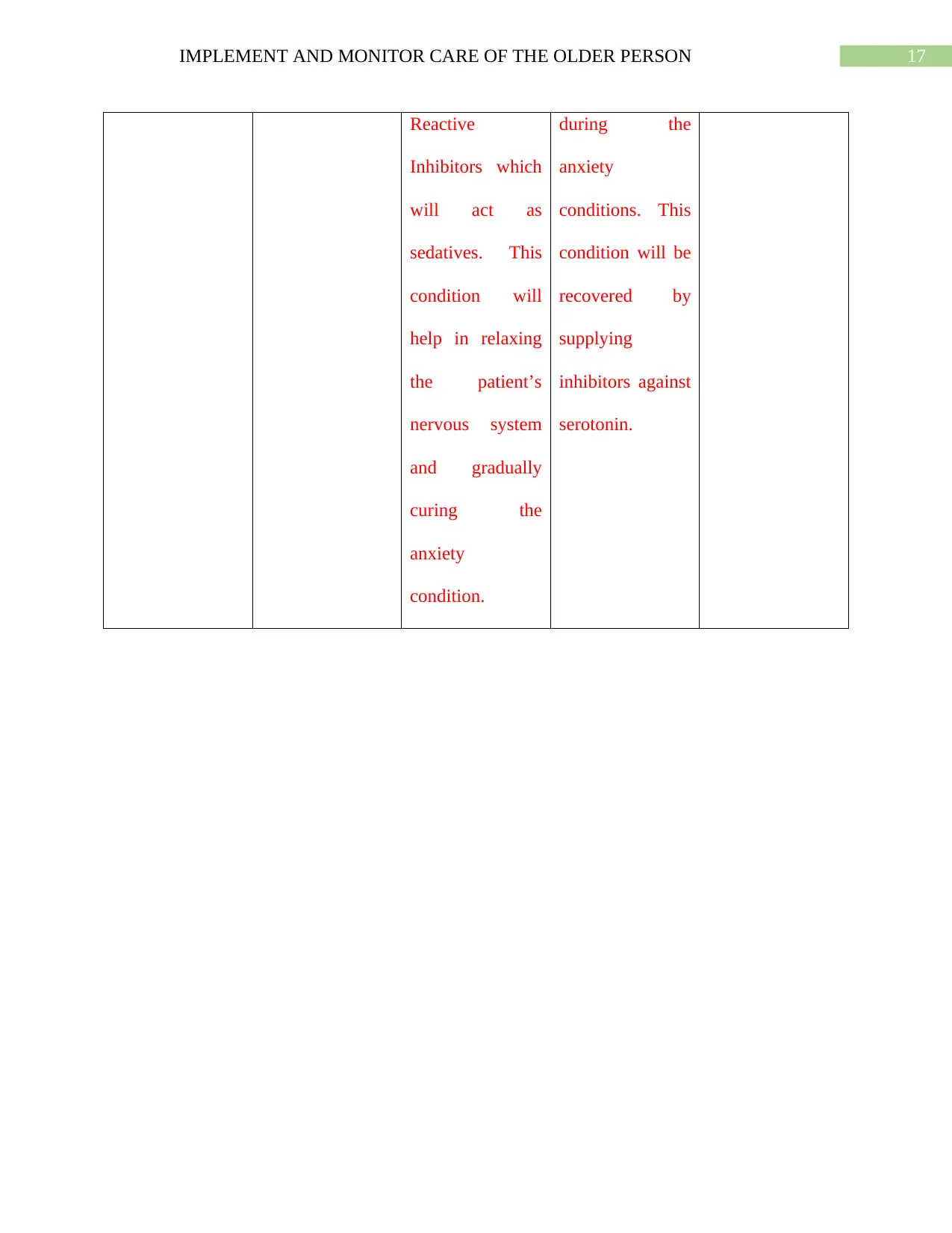
17IMPLEMENT AND MONITOR CARE OF THE OLDER PERSON
Reactive
Inhibitors which
will act as
sedatives. This
condition will
help in relaxing
the patient’s
nervous system
and gradually
curing the
anxiety
condition.
during the
anxiety
conditions. This
condition will be
recovered by
supplying
inhibitors against
serotonin.
Reactive
Inhibitors which
will act as
sedatives. This
condition will
help in relaxing
the patient’s
nervous system
and gradually
curing the
anxiety
condition.
during the
anxiety
conditions. This
condition will be
recovered by
supplying
inhibitors against
serotonin.
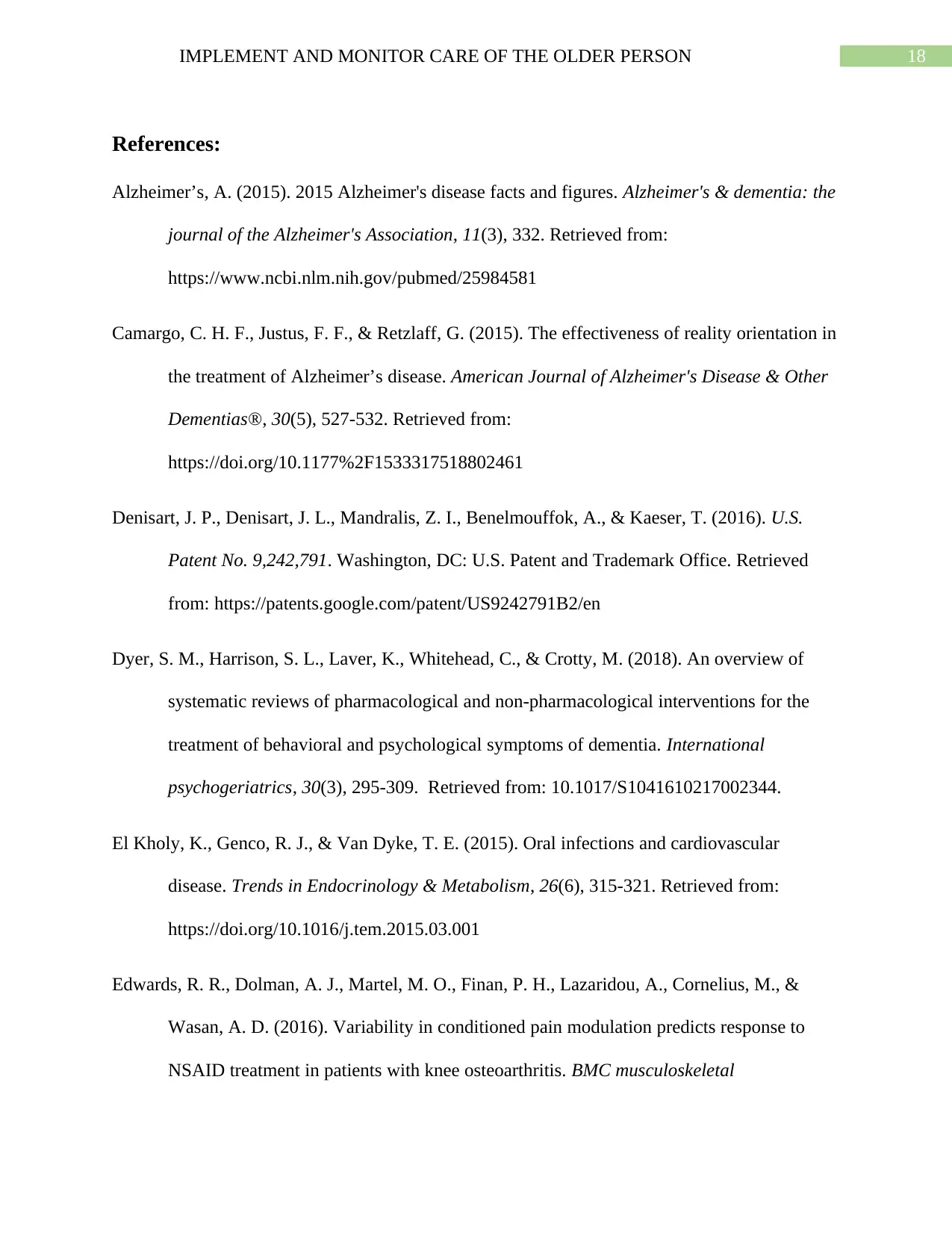
18IMPLEMENT AND MONITOR CARE OF THE OLDER PERSON
References:
Alzheimer’s, A. (2015). 2015 Alzheimer's disease facts and figures. Alzheimer's & dementia: the
journal of the Alzheimer's Association, 11(3), 332. Retrieved from:
https://www.ncbi.nlm.nih.gov/pubmed/25984581
Camargo, C. H. F., Justus, F. F., & Retzlaff, G. (2015). The effectiveness of reality orientation in
the treatment of Alzheimer’s disease. American Journal of Alzheimer's Disease & Other
Dementias®, 30(5), 527-532. Retrieved from:
https://doi.org/10.1177%2F1533317518802461
Denisart, J. P., Denisart, J. L., Mandralis, Z. I., Benelmouffok, A., & Kaeser, T. (2016). U.S.
Patent No. 9,242,791. Washington, DC: U.S. Patent and Trademark Office. Retrieved
from: https://patents.google.com/patent/US9242791B2/en
Dyer, S. M., Harrison, S. L., Laver, K., Whitehead, C., & Crotty, M. (2018). An overview of
systematic reviews of pharmacological and non-pharmacological interventions for the
treatment of behavioral and psychological symptoms of dementia. International
psychogeriatrics, 30(3), 295-309. Retrieved from: 10.1017/S1041610217002344.
El Kholy, K., Genco, R. J., & Van Dyke, T. E. (2015). Oral infections and cardiovascular
disease. Trends in Endocrinology & Metabolism, 26(6), 315-321. Retrieved from:
https://doi.org/10.1016/j.tem.2015.03.001
Edwards, R. R., Dolman, A. J., Martel, M. O., Finan, P. H., Lazaridou, A., Cornelius, M., &
Wasan, A. D. (2016). Variability in conditioned pain modulation predicts response to
NSAID treatment in patients with knee osteoarthritis. BMC musculoskeletal
References:
Alzheimer’s, A. (2015). 2015 Alzheimer's disease facts and figures. Alzheimer's & dementia: the
journal of the Alzheimer's Association, 11(3), 332. Retrieved from:
https://www.ncbi.nlm.nih.gov/pubmed/25984581
Camargo, C. H. F., Justus, F. F., & Retzlaff, G. (2015). The effectiveness of reality orientation in
the treatment of Alzheimer’s disease. American Journal of Alzheimer's Disease & Other
Dementias®, 30(5), 527-532. Retrieved from:
https://doi.org/10.1177%2F1533317518802461
Denisart, J. P., Denisart, J. L., Mandralis, Z. I., Benelmouffok, A., & Kaeser, T. (2016). U.S.
Patent No. 9,242,791. Washington, DC: U.S. Patent and Trademark Office. Retrieved
from: https://patents.google.com/patent/US9242791B2/en
Dyer, S. M., Harrison, S. L., Laver, K., Whitehead, C., & Crotty, M. (2018). An overview of
systematic reviews of pharmacological and non-pharmacological interventions for the
treatment of behavioral and psychological symptoms of dementia. International
psychogeriatrics, 30(3), 295-309. Retrieved from: 10.1017/S1041610217002344.
El Kholy, K., Genco, R. J., & Van Dyke, T. E. (2015). Oral infections and cardiovascular
disease. Trends in Endocrinology & Metabolism, 26(6), 315-321. Retrieved from:
https://doi.org/10.1016/j.tem.2015.03.001
Edwards, R. R., Dolman, A. J., Martel, M. O., Finan, P. H., Lazaridou, A., Cornelius, M., &
Wasan, A. D. (2016). Variability in conditioned pain modulation predicts response to
NSAID treatment in patients with knee osteoarthritis. BMC musculoskeletal
Paraphrase This Document
Need a fresh take? Get an instant paraphrase of this document with our AI Paraphraser
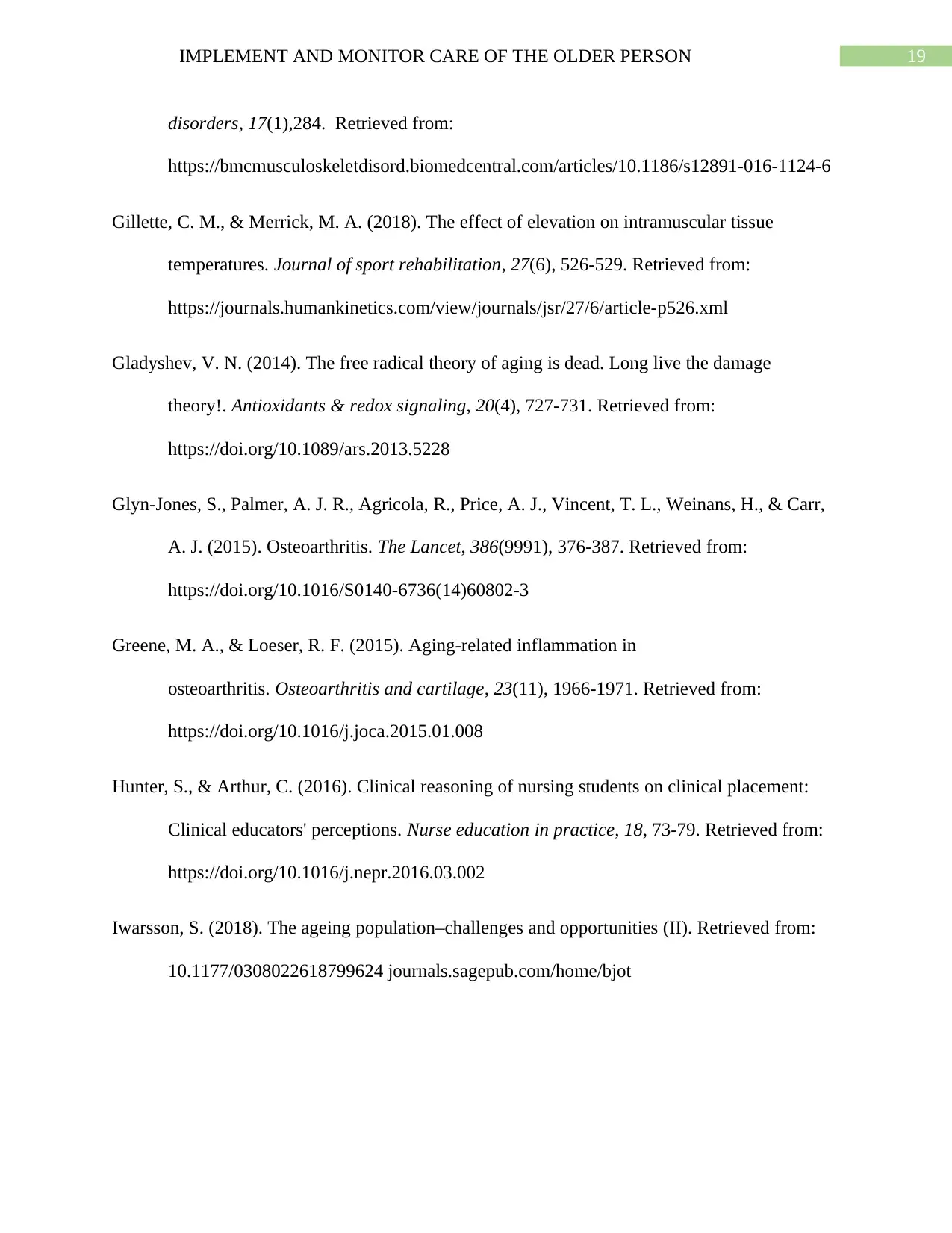
19IMPLEMENT AND MONITOR CARE OF THE OLDER PERSON
disorders, 17(1),284. Retrieved from:
https://bmcmusculoskeletdisord.biomedcentral.com/articles/10.1186/s12891-016-1124-6
Gillette, C. M., & Merrick, M. A. (2018). The effect of elevation on intramuscular tissue
temperatures. Journal of sport rehabilitation, 27(6), 526-529. Retrieved from:
https://journals.humankinetics.com/view/journals/jsr/27/6/article-p526.xml
Gladyshev, V. N. (2014). The free radical theory of aging is dead. Long live the damage
theory!. Antioxidants & redox signaling, 20(4), 727-731. Retrieved from:
https://doi.org/10.1089/ars.2013.5228
Glyn-Jones, S., Palmer, A. J. R., Agricola, R., Price, A. J., Vincent, T. L., Weinans, H., & Carr,
A. J. (2015). Osteoarthritis. The Lancet, 386(9991), 376-387. Retrieved from:
https://doi.org/10.1016/S0140-6736(14)60802-3
Greene, M. A., & Loeser, R. F. (2015). Aging-related inflammation in
osteoarthritis. Osteoarthritis and cartilage, 23(11), 1966-1971. Retrieved from:
https://doi.org/10.1016/j.joca.2015.01.008
Hunter, S., & Arthur, C. (2016). Clinical reasoning of nursing students on clinical placement:
Clinical educators' perceptions. Nurse education in practice, 18, 73-79. Retrieved from:
https://doi.org/10.1016/j.nepr.2016.03.002
Iwarsson, S. (2018). The ageing population–challenges and opportunities (II). Retrieved from:
10.1177/0308022618799624 journals.sagepub.com/home/bjot
disorders, 17(1),284. Retrieved from:
https://bmcmusculoskeletdisord.biomedcentral.com/articles/10.1186/s12891-016-1124-6
Gillette, C. M., & Merrick, M. A. (2018). The effect of elevation on intramuscular tissue
temperatures. Journal of sport rehabilitation, 27(6), 526-529. Retrieved from:
https://journals.humankinetics.com/view/journals/jsr/27/6/article-p526.xml
Gladyshev, V. N. (2014). The free radical theory of aging is dead. Long live the damage
theory!. Antioxidants & redox signaling, 20(4), 727-731. Retrieved from:
https://doi.org/10.1089/ars.2013.5228
Glyn-Jones, S., Palmer, A. J. R., Agricola, R., Price, A. J., Vincent, T. L., Weinans, H., & Carr,
A. J. (2015). Osteoarthritis. The Lancet, 386(9991), 376-387. Retrieved from:
https://doi.org/10.1016/S0140-6736(14)60802-3
Greene, M. A., & Loeser, R. F. (2015). Aging-related inflammation in
osteoarthritis. Osteoarthritis and cartilage, 23(11), 1966-1971. Retrieved from:
https://doi.org/10.1016/j.joca.2015.01.008
Hunter, S., & Arthur, C. (2016). Clinical reasoning of nursing students on clinical placement:
Clinical educators' perceptions. Nurse education in practice, 18, 73-79. Retrieved from:
https://doi.org/10.1016/j.nepr.2016.03.002
Iwarsson, S. (2018). The ageing population–challenges and opportunities (II). Retrieved from:
10.1177/0308022618799624 journals.sagepub.com/home/bjot
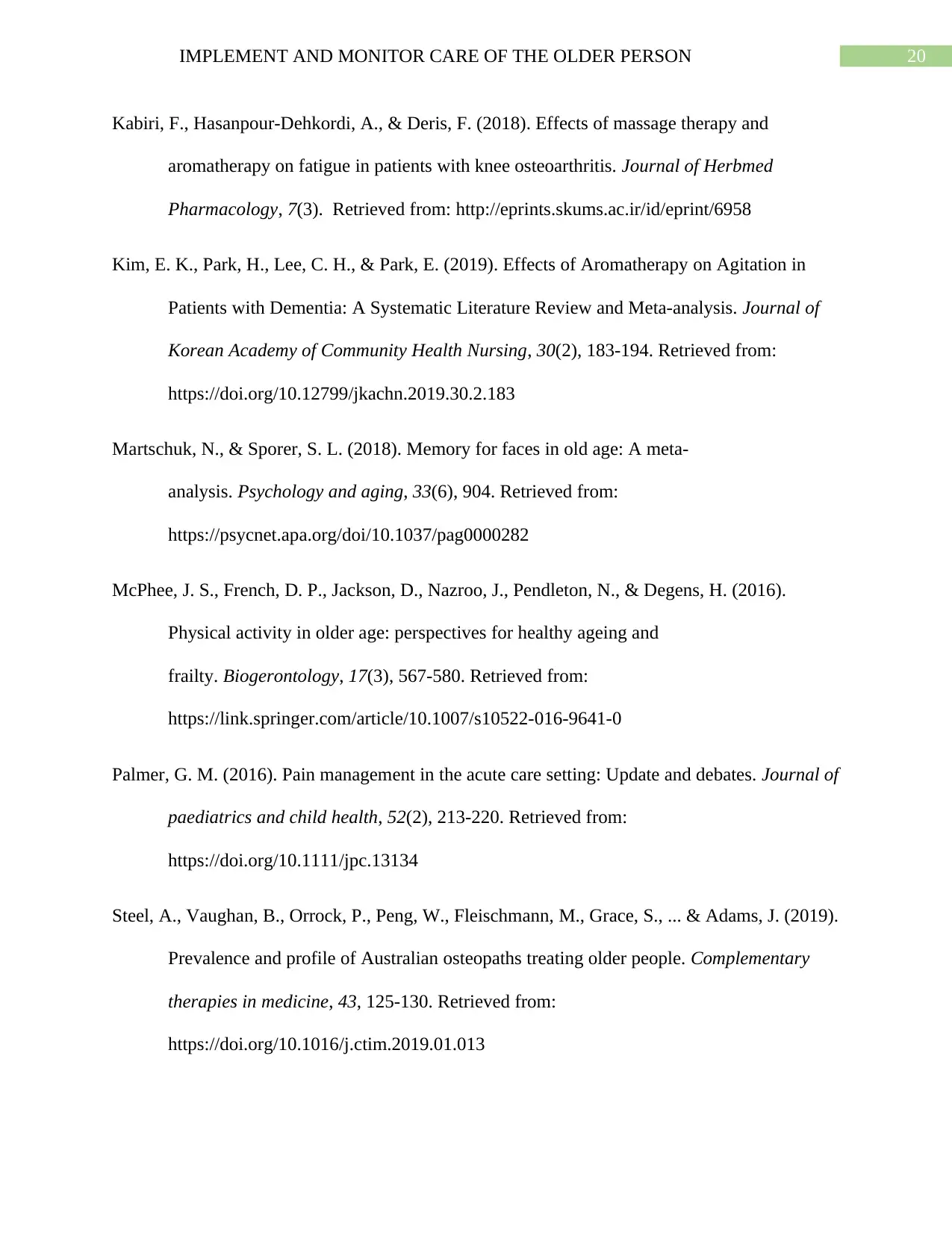
20IMPLEMENT AND MONITOR CARE OF THE OLDER PERSON
Kabiri, F., Hasanpour-Dehkordi, A., & Deris, F. (2018). Effects of massage therapy and
aromatherapy on fatigue in patients with knee osteoarthritis. Journal of Herbmed
Pharmacology, 7(3). Retrieved from: http://eprints.skums.ac.ir/id/eprint/6958
Kim, E. K., Park, H., Lee, C. H., & Park, E. (2019). Effects of Aromatherapy on Agitation in
Patients with Dementia: A Systematic Literature Review and Meta-analysis. Journal of
Korean Academy of Community Health Nursing, 30(2), 183-194. Retrieved from:
https://doi.org/10.12799/jkachn.2019.30.2.183
Martschuk, N., & Sporer, S. L. (2018). Memory for faces in old age: A meta-
analysis. Psychology and aging, 33(6), 904. Retrieved from:
https://psycnet.apa.org/doi/10.1037/pag0000282
McPhee, J. S., French, D. P., Jackson, D., Nazroo, J., Pendleton, N., & Degens, H. (2016).
Physical activity in older age: perspectives for healthy ageing and
frailty. Biogerontology, 17(3), 567-580. Retrieved from:
https://link.springer.com/article/10.1007/s10522-016-9641-0
Palmer, G. M. (2016). Pain management in the acute care setting: Update and debates. Journal of
paediatrics and child health, 52(2), 213-220. Retrieved from:
https://doi.org/10.1111/jpc.13134
Steel, A., Vaughan, B., Orrock, P., Peng, W., Fleischmann, M., Grace, S., ... & Adams, J. (2019).
Prevalence and profile of Australian osteopaths treating older people. Complementary
therapies in medicine, 43, 125-130. Retrieved from:
https://doi.org/10.1016/j.ctim.2019.01.013
Kabiri, F., Hasanpour-Dehkordi, A., & Deris, F. (2018). Effects of massage therapy and
aromatherapy on fatigue in patients with knee osteoarthritis. Journal of Herbmed
Pharmacology, 7(3). Retrieved from: http://eprints.skums.ac.ir/id/eprint/6958
Kim, E. K., Park, H., Lee, C. H., & Park, E. (2019). Effects of Aromatherapy on Agitation in
Patients with Dementia: A Systematic Literature Review and Meta-analysis. Journal of
Korean Academy of Community Health Nursing, 30(2), 183-194. Retrieved from:
https://doi.org/10.12799/jkachn.2019.30.2.183
Martschuk, N., & Sporer, S. L. (2018). Memory for faces in old age: A meta-
analysis. Psychology and aging, 33(6), 904. Retrieved from:
https://psycnet.apa.org/doi/10.1037/pag0000282
McPhee, J. S., French, D. P., Jackson, D., Nazroo, J., Pendleton, N., & Degens, H. (2016).
Physical activity in older age: perspectives for healthy ageing and
frailty. Biogerontology, 17(3), 567-580. Retrieved from:
https://link.springer.com/article/10.1007/s10522-016-9641-0
Palmer, G. M. (2016). Pain management in the acute care setting: Update and debates. Journal of
paediatrics and child health, 52(2), 213-220. Retrieved from:
https://doi.org/10.1111/jpc.13134
Steel, A., Vaughan, B., Orrock, P., Peng, W., Fleischmann, M., Grace, S., ... & Adams, J. (2019).
Prevalence and profile of Australian osteopaths treating older people. Complementary
therapies in medicine, 43, 125-130. Retrieved from:
https://doi.org/10.1016/j.ctim.2019.01.013
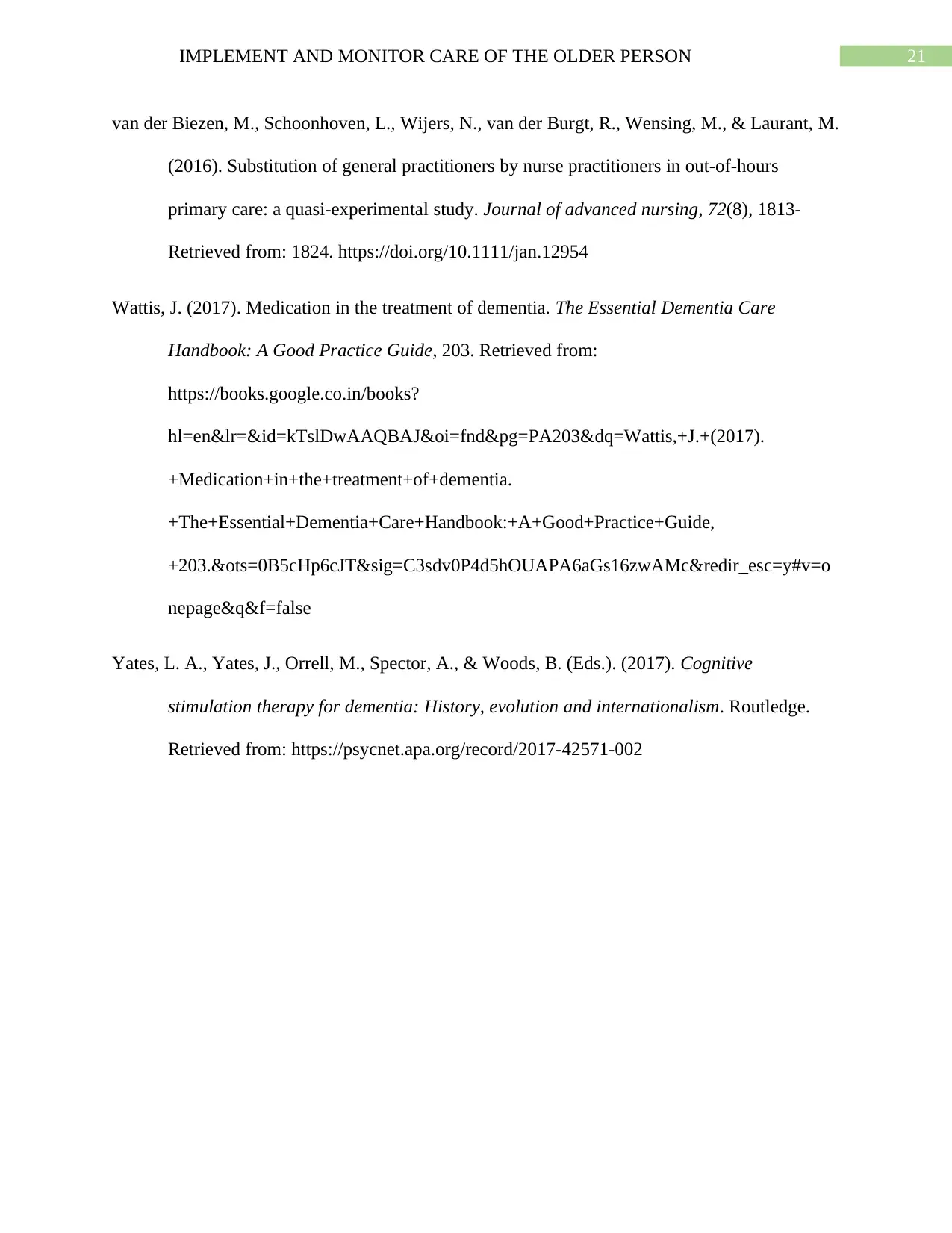
21IMPLEMENT AND MONITOR CARE OF THE OLDER PERSON
van der Biezen, M., Schoonhoven, L., Wijers, N., van der Burgt, R., Wensing, M., & Laurant, M.
(2016). Substitution of general practitioners by nurse practitioners in out‐of‐hours
primary care: a quasi‐experimental study. Journal of advanced nursing, 72(8), 1813-
Retrieved from: 1824. https://doi.org/10.1111/jan.12954
Wattis, J. (2017). Medication in the treatment of dementia. The Essential Dementia Care
Handbook: A Good Practice Guide, 203. Retrieved from:
https://books.google.co.in/books?
hl=en&lr=&id=kTslDwAAQBAJ&oi=fnd&pg=PA203&dq=Wattis,+J.+(2017).
+Medication+in+the+treatment+of+dementia.
+The+Essential+Dementia+Care+Handbook:+A+Good+Practice+Guide,
+203.&ots=0B5cHp6cJT&sig=C3sdv0P4d5hOUAPA6aGs16zwAMc&redir_esc=y#v=o
nepage&q&f=false
Yates, L. A., Yates, J., Orrell, M., Spector, A., & Woods, B. (Eds.). (2017). Cognitive
stimulation therapy for dementia: History, evolution and internationalism. Routledge.
Retrieved from: https://psycnet.apa.org/record/2017-42571-002
van der Biezen, M., Schoonhoven, L., Wijers, N., van der Burgt, R., Wensing, M., & Laurant, M.
(2016). Substitution of general practitioners by nurse practitioners in out‐of‐hours
primary care: a quasi‐experimental study. Journal of advanced nursing, 72(8), 1813-
Retrieved from: 1824. https://doi.org/10.1111/jan.12954
Wattis, J. (2017). Medication in the treatment of dementia. The Essential Dementia Care
Handbook: A Good Practice Guide, 203. Retrieved from:
https://books.google.co.in/books?
hl=en&lr=&id=kTslDwAAQBAJ&oi=fnd&pg=PA203&dq=Wattis,+J.+(2017).
+Medication+in+the+treatment+of+dementia.
+The+Essential+Dementia+Care+Handbook:+A+Good+Practice+Guide,
+203.&ots=0B5cHp6cJT&sig=C3sdv0P4d5hOUAPA6aGs16zwAMc&redir_esc=y#v=o
nepage&q&f=false
Yates, L. A., Yates, J., Orrell, M., Spector, A., & Woods, B. (Eds.). (2017). Cognitive
stimulation therapy for dementia: History, evolution and internationalism. Routledge.
Retrieved from: https://psycnet.apa.org/record/2017-42571-002
1 out of 22
Related Documents
Your All-in-One AI-Powered Toolkit for Academic Success.
+13062052269
info@desklib.com
Available 24*7 on WhatsApp / Email
![[object Object]](/_next/static/media/star-bottom.7253800d.svg)
Unlock your academic potential
© 2024 | Zucol Services PVT LTD | All rights reserved.





